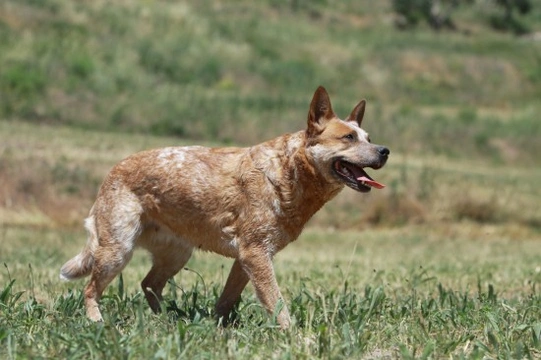
Temperament, personality and behaviour of the Australian Cattle Dog
The Australian Cattle Dog, also sometimes known as the Blue Heeler, is a herding and livestock working dog from Australia that is now recognised within the UK. The origins of the breed are interesting, being as they consist of a crossing of domestic dogs (possibly from the Collie grouping) imported into Australia by settlers, then crossed with the nation’s wild dog breed, the Dingo.
While the foundations of the breed involve the wild Dingo, a dog that was made famous in the press in the 1980’s for attacking and killing a human baby, the Australian Cattle Dog is a domestic dog breed, and one that is rising in popularity in the UK as both a pet and a working animal.
If you are wondering if the Australian Cattle Dog would make a viable pet for you and are interested in learning more about them, read on to find out about the temperament, personality and behaviour of this unusual breed.
Personality
The Australian Cattle Dog is an incredibly inquisitive, alert and lively breed of dog, which is happiest when it has something to do! They are intelligent and good at problem solving, and will easily become bored if not properly entertained. They are renowned for their protective instincts over their territory and immediate family, their loyalty, and their courage. They are also very watchful and will soon alert you to the approach of a stranger or something unusual happening on their territory, day or night!
Exercise requirements
The Australian Cattle Dog is an incredibly high-energy dog, with exercise requirements right at the top of the canine scale and equivalent to that of the Siberian Husky or Border Collie. They do not make a good fit for homes where they cannot spend a significant amount of time out of doors, or smaller homes that do not allow them to stretch their legs. However, if you live in a rural area or have plenty of fields and parks near to your home that you can use for walking, the Australian Cattle dog might be a good fit.
They need to be walked at least two to three times a day if not allowed free access to the outdoors, and require long, energetic walks and exercise.
Temperament with people
The Australian Cattle Dog generally bonds strongly with their human family, accepting all members of the family into their pack and having a close relationship with all parties. They are relatively wily dogs and will often assume that they are the pack alpha unless correctly trained otherwise, and incorrectly trained, they have a tendency to be rather pushy, bossy and destructive. However, they are not renowned for being snappy or aggressive, so while they need clear, consistent and confident handling, they are unlikely to become aggressive with their own family.
Temperament with other animals
The Australian Cattle Dog is used to working in teams with other dogs, and is perfectly suitable for keeping in a multi-dog household. They do tend to be fairly dominant, however, and will often take the alpha role or battle for the position over time with other dogs in the family.
Out in the street or the dog park, the Australian Cattle Dog is again a social dog that will enjoy running around and playing with others, but again, they will have a tendency to try to take the alpha role, and can be rather bossy!
Because the breed was created and selectively bred as a livestock herding dog, they have strong herding instincts, and may display these in all manner of situations. If out walking in the country, it is vitally important to ensure that your dog will not take off and decide to start herding some unsuspecting livestock, and teaching correct recall and appropriate outlets for their herding instinct is important.
In terms of smaller household animals, the Australian Cattle Dog can potentially live with smaller animals such as cats, and they are more likely to attempt to herd these too than eat them, providing that they are properly introduced and managed!
Training
The Australian Cattle Dog requires a confident and experienced trainer, and one that can handle potential bids for dominance and unruly behaviour. The breed learns very quickly, and so they can soon get bored with too much repetition, but are more than capable of learning lots of different commands and complex, chain commands. Exercise and training should be paired together, and allowing your dog off the lead time in a large open area while working on commands such as recall, changes of direction and other activities to keep the dog guessing are a good idea.
The breed is also well suited to energetic sports that also require a high level of intelligence, such as flyball or agility, so consider getting involved with these with your dog as well.



